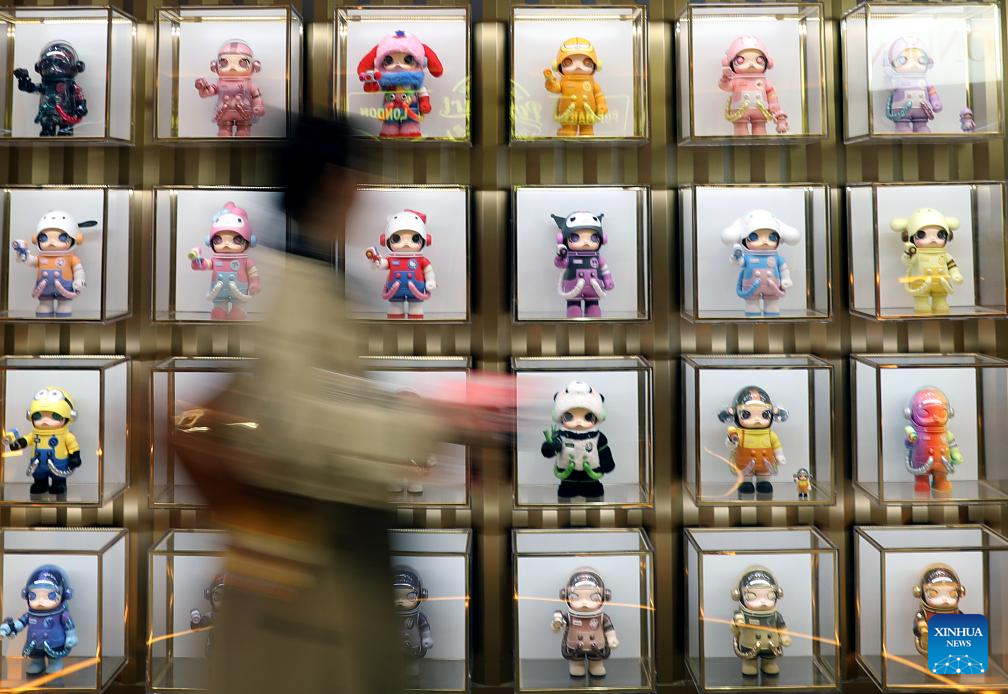Cute and quirky dolls made in China are gaining popularity from commercial hubs in Europe to shopping malls across Southeast Asia, driven by China's manufacturing capabilities, the broad appeal of homegrown brands, and growing emotional connections with consumers worldwide.

Customers purchase products at a POP MART store in London, Britain, on May 21, 2025. (Xinhua/Li Ying)
Over the past two years, Chinese fashion toys have become a global trend. Outside Chinese retailer Miniso's flagship store on the Champs-Élysées in Paris, customers line up. On social media, Chinese toy company Pop Mart's toothy and fluffy character Labubu has become a fan favorite. In China, foreign tourists often leave stores with bags full of trendy toys.
In 2024, Miniso's toy brand Top Toy opened in a mall in Malaysia. "The store has been a hit with local shoppers since day one," said Joyce Yap, the mall's CEO.
The data tells the story. Pop Mart's 2024 annual report shows revenue from the Chinese mainland reached 7.97 billion yuan (about $1.11 billion), up 52.3 percent year on year. Overseas markets, as well as Hong Kong, Macao and Taiwan, brought in 5.07 billion yuan, a surge of 375.2 percent year on year. Revenue reached 2.4 billion yuan in Southeast Asia, rose 556.9 percent year on year in North America, and increased 310.7 percent year on year in Europe, Australia and other markets.

Customers line up in front of a POP MART store in Seoul, South Korea, on May 20, 2025. (Xinhua/Yao Qilin)
Miniso is focusing on products based on popular brands and characters as it speeds up expansion both in China and overseas. As of March 2025, the company had stores in 112 countries and regions, with more than 3,200 overseas locations. In the first quarter of 2025, overseas revenue reached 1.59 billion yuan, up 30 percent year on year.
According to Liu Xiaobin, vice president of Miniso Group, the global success of Chinese fashion toys is driven by a powerful combination of China's manufacturing strength and the cultural appeal of homegrown IP.
"China's supply chain leads the world in both production and logistics efficiency. We work closely with more than 1,400 premium suppliers globally — 80 percent of them in China," Liu said.
"For domestic stores, delivery from supplier to shelf takes just three to seven days. For overseas stores, it's usually 20 to 30 days, still faster than most global standards," Liu added.
Pop Mart Chairman Wang Ning said Labubu's design has universal appeal. In 2024, "The Monsters" series featuring Labubu brought in 3.04 billion yuan, up 726.6 percent year on year, making it Pop Mart's top IP.

A woman purchases products at a POP MART store in London, Britain, on May 21, 2025. (Xinhua/Li Ying)
"We've nurtured artists worldwide. These artists create IPs that resonate globally and help take our brand further across borders," a Pop Mart executive said.
China's toy industry has made its mark on the world stage. A recent Citibank report notes that retail sales of China's IP-based products reached 71.5 billion yuan in 2022 and are expected to exceed 100 billion yuan by 2027, with a compound annual growth rate of more than 20 percent.
"Our consumers and artists come from around the world, and our fashion toys have become a universal cross-cultural language," the Pop Mart executive said. He emphasized that these toys are not just a way to express individuality — they've also become a form of social currency for young people worldwide, gaining significance through constant sharing and interaction.
"In 2024, I visited 18 countries and toured 400 to 500 malls. I deeply felt the global market's keen focus on China," said Sun Yuanwen, founder and CEO of Top Toy.
"Chinese fashion toys have earned global recognition by using cuteness to bridge cultural gaps, leading the world to embrace Chinese aesthetics. At its core, this reflects the younger generation's open and inclusive acceptance of Chinese culture," Sun said.
(Source: People's Daily Online)
